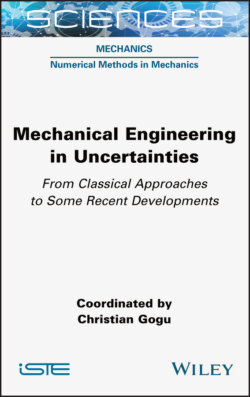Читать книгу Mechanical Engineering in Uncertainties From Classical Approaches to Some Recent Developments - Группа авторов - Страница 30
1.10. References
ОглавлениеApostolakis, G. (1999). The distinction between aleatory and epistemic uncertainties is important: An example from the inclusion of aging effects into PSA. Proceedings of PSA ‘99, International Topical Meeting on Probabilistic Safety Assessment, 135–142.
Dempster, A.P. (1967). Upper and lower probabilities induced by a multivalued mapping. Ann. Math. Stat., 38, 325–339.
Der Kiureghian, A. and Ditlevsen, O. (2009). Aleatory or epistemic? Does it matter? Structural Safety, 31(2), 105–112.
Dubois, D. and Prade, H. (1992). Combination of fuzzy information in the framework of possibility theory. In Data Fusion in Robotics and Machine Intelligence, Della Riccia, G., Lenz, H.J. and Fruse, R. (eds). Academic Press, New York.
Dvoretzky, A., Kiefer, J. and Wolfowitz, J. (1956). Asymptotic minimax character of the sample distribution function and of the classical multinomial estimator. The Annals of Mathematical Statistics, 27(3), 642–669.
Ferson, S., Joslyn, C.A., Helton, J.C., Oberkampf, W.L. and Sentz, K. (2004). Summary from the epistemic uncertainty workshop: Consensus amid diversity. Reliability Engineering and System Safety, 85, 355–369.
Ferson, S., Kreinovich, V., Grinzburg, L., Myers, D. and Sentz, K. (2015). Constructing probability boxes and Dempster–Shafer structures. Technical report, SAND-2015-4166J, Sandia National Lab, Albuquerque.
Hansen, E. and Walster, G.W. (2003). Global Optimization Using Interval Analysis: Revised and Expanded. CRC Press, Boca Raton.
Hoffman, F.O. and Hammonds, J.S. (1994). Propagation of uncertainty in risk assessments: The need to distinguish between uncertainty due to lack of knowledge and uncertainty due to variability. Risk Analysis, 14(5), 707–712.
Klir, G.J. (2004). Generalized information theory: Aims, results, and open problems. Reliability Engineering and System Safety, 85, 355–369.
Kreinovich, V. and Xiang, G. (2008). Fast algorithms for computing statistics under interval uncertainty: An overview. In Interval/Probabilistic Uncertainty and Non-classical Logics, Huynh, V.N., Nakamori, Y., Ono, H., Lawry, J., Kreinovich, V., Nguyen, H.T. (eds). Springer, Berlin.
Lemaire, M. (2014). Mechanics and Uncertainty. ISTE Ltd, London and John Wiley & Sons, New York.
National Research Council (2009). Evaluation of Quantification of Margins and Uncertainties Methodology for Assessing and Certifying the Reliability of the Nuclear Stockpile. The National Academies Press, Washington, D.C.
Nikolaidis, E., Chen, S., Cudney, H., Hatftka, R.T. and Rosca, R. (2004). Comparison of probability and possibility for design against catastrophic failure under uncertainty. Journal of Mechanical Design, 126(3), 386–394.
Oberguggenberger, M., King, J. and Schmelzer, B. (2009). Classical and imprecise probability methods for sensitivity analysis in engineering: A case study. International Journal of Approximate Reasoning, 50(4), 680–693.
Roy, C.J. and Balch, M.S. (2012). A holistic approach to uncertainty quantification with application to supersonic nozzle thrust. International Journal for Uncertainty Quantification, 2(4), 363–381.
Sentz, K. and Ferson, S. (2002). Combination of evidence in Dempster–Shafer theory. Technical report, SAND2002-0835, Sandia National Lab, Albuquerque.
Shafer, G. (1976). A Mathematical Theory of Evidence. Princeton University Press, Princeton. Silverman, B.W. (2018). Density Estimation for Statistics and Data Analysis. Routledge, New York.
Vose, D. (2008). Risk Analysis: A Quantitative Guide. John Wiley & Sons, New York. Wagner, R.L. (2003). Science, uncertainty and risk: The problem of complex phenomena. APS News, 1(12), 8.
Walley, P. (1991). Statistical Reasoning with Imprecise Probabilities. Chapman and Hall, London.
Walley, P. (2000). Towards a unified theory of imprecise probability. International Journal of Approximate Reasoning, 24, 125–148.
Zhang, H., Mullen, R.L. and Muhanna, R.L. (2011). Structural analysis with probability-boxes. International Journal of Reliability and Safety, 6(1–3), 110–129.
Zimmermann, H.J. (2011). Fuzzy Set Theory and Its Applications. Springer, The Hague.
